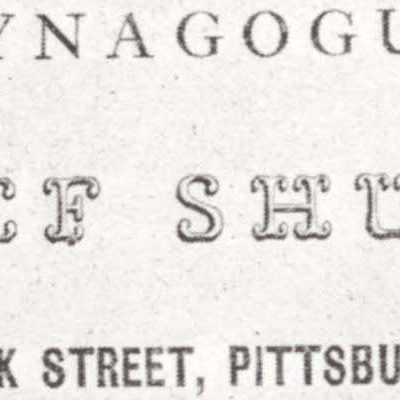
Rodef Shalom Congregation and Shaare Shamayim Congregation operated separate afternoon religious schools in the 1850s. For a time, the Rodef Shalom religious school included branches in downtown Pittsburgh and in Allegheny City. The two congregations merged in fall 1860, combining their student bodies. Rodef Shalom also operated a parochial day school starting in April 1860. The day school closed around 1868 but the afternoon religious school continued. It was reorganized in 1885 during the rabbinate of Dr. Lippman Meyer and reorganized again in 1901 during the rabbinate of Dr. J. Leonard Levy, eventually evolving into the Rodef Shalom Religious School after World War I.
Tree of Life Congregation started a religious school in 1864, alongside the founding of the congregation. President Alexander Fink oversaw the school with assistance from the cantor and the sexton of the congregation for some 20 years. Abraham Goldstein was hired as sexton and teacher in 1884, followed by Marcus Rosenthal. The school was reorganized during the rabbinate of Rabbi Michael Fried and during the rabbinate of Rev. Dr. Rudolph I Coffee.
Beth Hamedrash Hagodol Congregation started its afternoon religious school for boys and girls in 1902, during the rabbinate of Rabbi Aaron Mordechai Ashinsky. Beth Jacob Congregation, Machsikei Hadas Congregation, Tiphereth Israel Congregation, and Rabbi Moshe Shimon Sivitz’s Talmud Torah all operated afternoon chederim exclusively for boys in the first decade of the 20th century. By 1908-1909, 1,019 students were enrolled at these seven religious schools—533 boys and 486 girls. There were also 46 boys and girls in a religious school based out of the J. M. Gusky Orphange, and 396 boys attending the Columbian Council School (later the Irene Kaufmann Settlement House). According to the American Jewish Yearbook, Poale Zedeck Congregation (65 students) and Ahavas Sholem in the Strip District (32 students) were operating weekly schools by 1908. It is also likely that many of the smaller Jewish congregations in various neighborhoods throughout the city operated Sunday schools or afternoon religious schools for children.
In addition to these congregational and institutional religious schools, several tutors offered private chederim (Hebrew schools) in the Hill District exclusively for boys. These include Mr. Chernoff (Ross and Dinwiddie), Mr. S. Galantz (27 Carpenter Way), Mr. Geffen (1225 Franklin St.), Mr. Kamenetzky (1312 Clark St.), Mr. H. Lefsovsky (21 Townsend St., rear), Mr. Tolotzky (1308 Franklin St.), and schools at 64 Crawford St. and at Crawford and Center. These eight independent chederim had 142 students in the 1908-1909 survey.
The system of local Jewish religious education entered a new era in the late 1910s and early 1920s with the creation of two new communitywide resources: the Hebrew Institute and the Southwestern District of Pennsylvania Jewish Religious Schools Program.